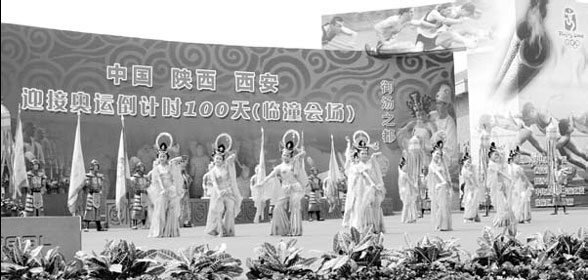Ancient Xi'an treasures and culture still vibrant
|
Lintong performance for the 100-day countdown to the Games |
On the south bank of Weihe River at the foot of the Qinling Mountains, Xi'an, capital of Shaanxi province, is world-renowned for its archaeological treasures and rich cultural heritage.
With a history stretching back more than 5,000 years, Xi'an was the capital of 13 dynasties including the Zhou (11th century BC - 771 BC), Qin (221-206 BC), Han (206 BC- AD 220) and Tang (618-907).
Many of the city's cultural heritage sites lie in its northeast Lintong district.
Termed "the source of Chinese civilization," Lintong has seen the collision and integration of splendid ancient culture with modern civilization.
The district has hundreds of ancient sites, thousands of tombs and tens of thousands of precious archaeological items on display and in collections.
Lintong boasts dozens of the country's top sites, including the Qin terracotta warriors and horses, Huaqing Pool, the Qin Shihuang Mausoleum and the Lishan National Forest Park. The district hosts more than 7 million visitors annually.
As the Beijing Olympic Games approach, Lintong aims to attract more tourists from home and abroad to enjoy both its ancient and modern civilization.
Qin Shihuang's mausoleum and terracotta warriors and horses
Visitors are often overwhelmed by the grandeur and mystery of the Museum of Qin Shihuang's Terracotta Warriors and Horses, but the museum is only part of the tomb and greater secrets are expected to be unveiled.
Qin Shihuang (259 BC - 210 BC), the first emperor of China, took throne at the age of 13 and immediately began construction of his tomb.
Terracotta warriors and horses served to guard the mausoleum of the first emperor.
Located in Lishan Mountain in eastern Lintong, 35 kilometers east of downtown Xi'an, the mausoleum is regarded as "the eighth wonder of the world" and listed as a UNESCO world heritage site in 1987.
It draws millions of visitors from home and abroad every year.
Construction of Qin Shihuang's tomb, which involved more than 700,000 laborers, expanded after he unified China in 221 BC. It was completed 38 years later.
The mausoleum has a square rammed earth base that is still 76 meters high. The coffin and chamber of Qin Shihuang are in the center of the underground palace.
The mausoleum site contains more than 400 tombs and vaults that cover an area of 56.25 sq km.
Underground wonders include the vault of the bronze carriage, the vault of horses, the vault of rare and precious birds and animals, the vault of stables and the vault of warriors and horses.
Nearly 8,000 life-sized terracotta warriors and horses along with tens of thousands weapons have been uncovered from three pits where the terracotta warriors and horses slept for almost 2,200 years.
Many of the statues wear overcoats and armament, with each having a weapon in its hands. They also wore leather waistbands, a pair of square shoes and leggings, typical dress of about 2,200 years ago.
Some 50,000 relics have been unearthed, including a painted bronze carriage drawn by two bronze horses.
The carriage, the largest and most elegant of its type discovered in China, is made of more than 3,000 pieces, more than 1,000 of which are gold or silver.
Huaqing Pool
At the foot of the Lishan Mountain, Huaqing Pool was a favorite for emperors over hundreds of years who came to bathe and enjoy the scenic beauty. It has been a favorite spa since the Tang Dynasty.
As early as in the Zhou Dynasty in the 11th century BC, King Zhouyou built a resort palace at the hot spring.
Later Emperor Qin Shihuang built a stone pool and gave it the name Lishan Hot Springs. It was later extended by emperors in the Han and Sui dynasties.
During the Tang Dynasty, Emperor Xuanzong ordered large-scale construction called Huaqing Palace that transformed the site to have indoor pools.
Most of the present buildings are in the style of the Tang.
Visitors can also visit the Nine-Dragon Hot Spring Pool originally built with crystal jade beautifully decorated with carvings of fish, birds and flowers, and the Lotus Flower Pool, a lotus-shaped bathing pool fed by spring water .
The Tang Emperor Xuanzong used to spend winter in the Hall of Fluttering Frost in the company of Yang Guifei, his favorite concubine. The hall was named for the milky mist and vapors that rise from the pool year-around.
Winter snowflakes melted immediately in front of the hall because of warm vapor rising from the hot spring.
Most of the pools were rebuilt in 1959 in Tang architectural style.
(China Daily 05/13/2008 page20)















